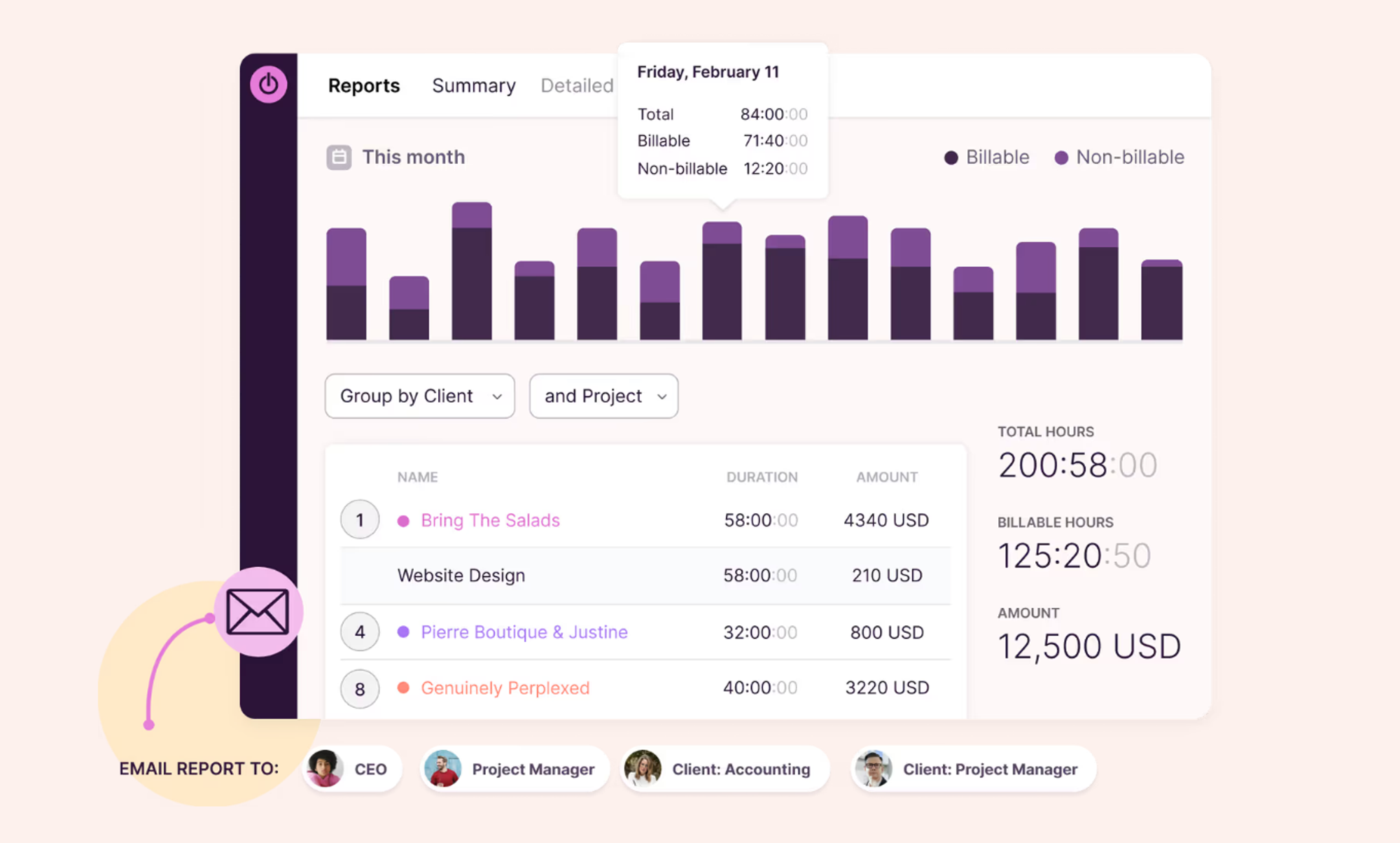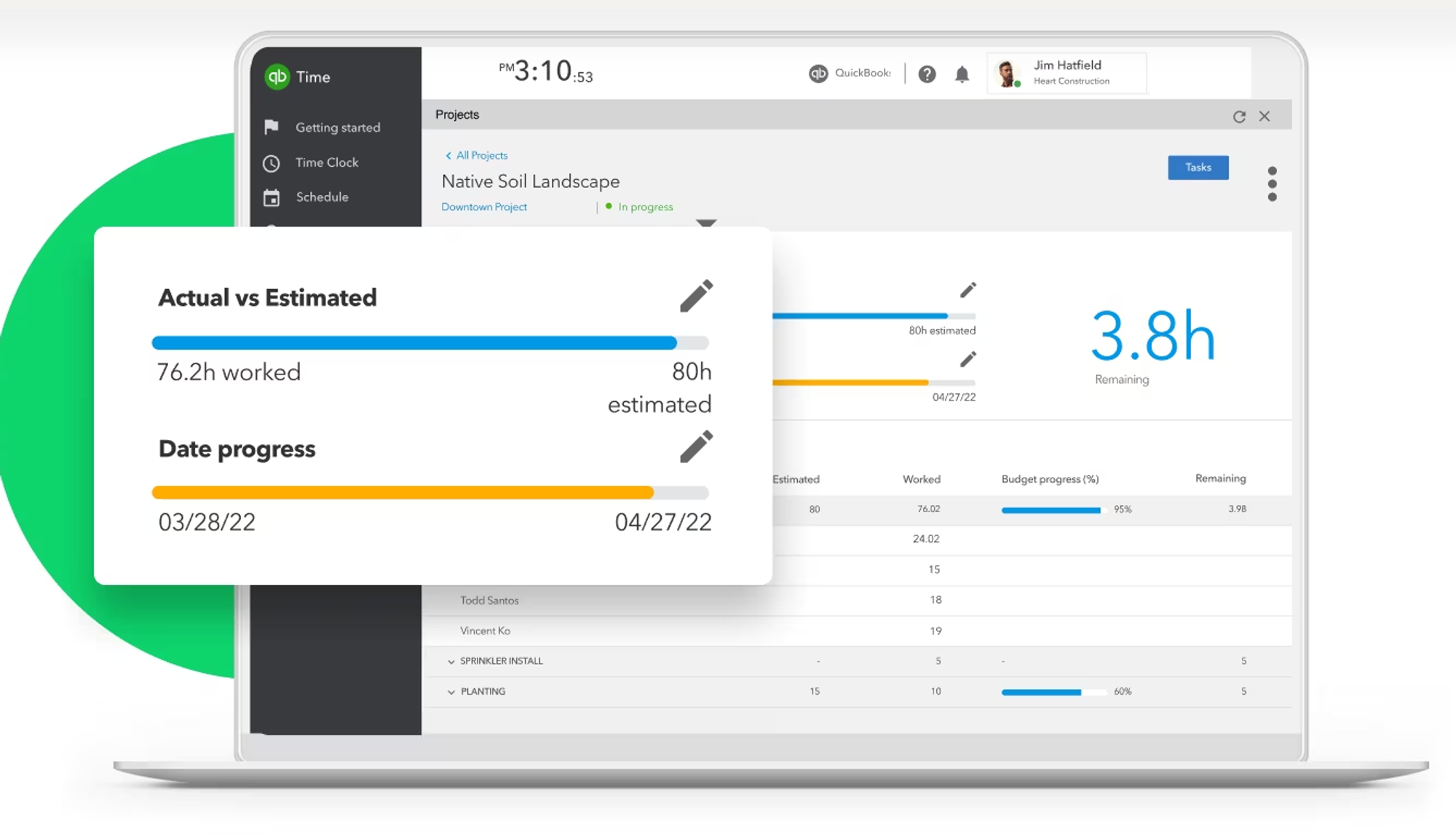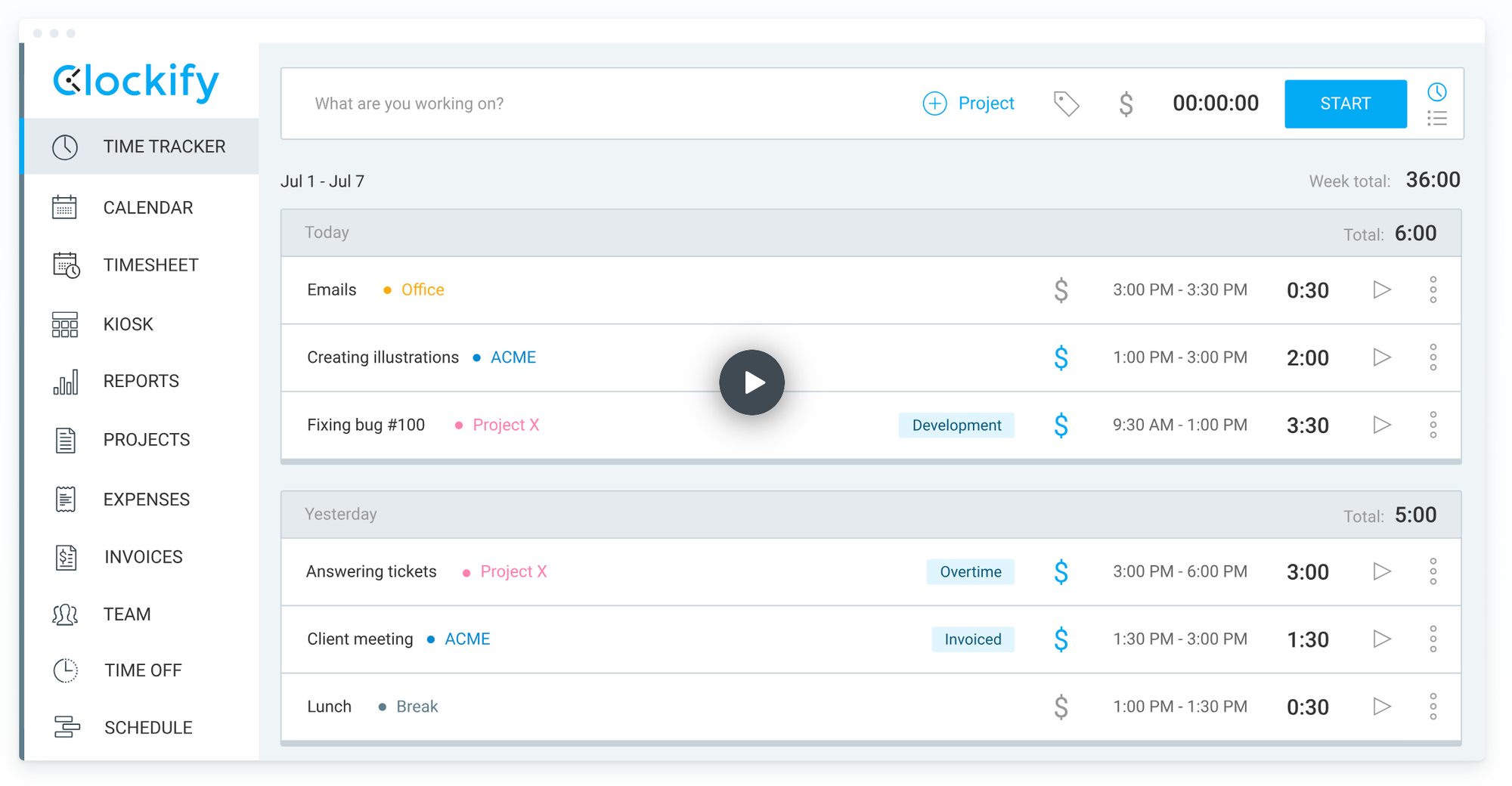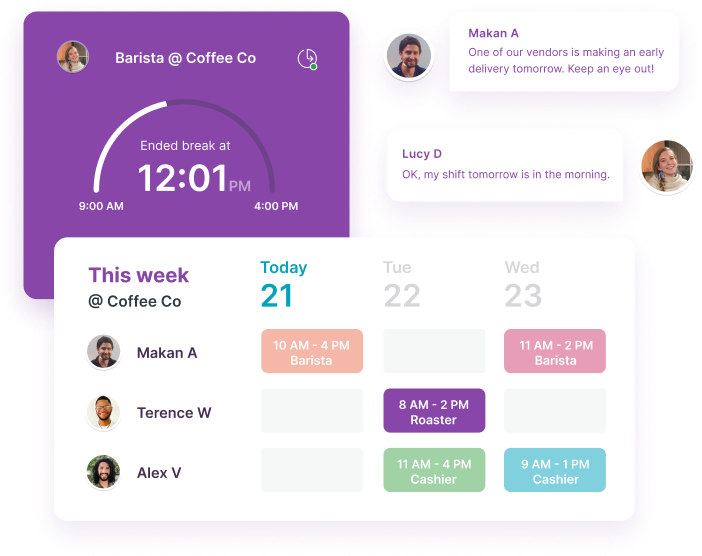Want to save time and money? (We’re assuming that’s a resounding ‘yes please’.) Then time entry software is going to be your new best friend.
Time entry is the act of employees recording and tracking the time they start and end work for the day or on a specific task on a timesheet. It’s your job to then take those timesheets and turn them into paychecks. Unfortunately, it’s easier said than done.
This is why small businesses are turning to time entry software to make all of their payroll tasks easy peasy. In this article, we talk about time entry software, the benefits of using one, some common struggles businesses face with time entry, and the top 5 time entry software for 2024 to keep on your radar.
If you have a 2024 goal of making your systems run smoothly, this article is for you.
What is Time Entry Software?
A time entry software is a tool that lets you record, track, and manage the time spent at work or on various tasks, giving you a clearer picture of where your staffing hours are going and where your employee’s hours are being spent.
It’s basically a fancy tool that encompasses a time clock, time tracking, and timesheets wrapped into one. This is why small businesses are changing their old paper ways to new digital ones.
Struggles Small Businesses Face with Time Entry
Even though time tracking is a daily business task, that doesn’t mean that businesses have it all figured out. Time entry can be a massive headache for small business because of the inevitable pitfalls, but it’s a necessary evil of doing business.
Let’s take a look at the 3 most common struggles small businesses face with time entry.
1. Inaccurate time tracking and buddy punching
If you have staff rolling in 5-10 minutes late every shift, but they mark themselves down as being on time, you’ve got a time tracking problem. And those minutes add up fast. If you compound that with employees popping out of work a little bit early, but marking themselves as leaving on time, well, now you’re risking losing out on way more time paid than just a few minutes here and there. This inaccurate time tracking is hurting your bottom line.
Unfortunately, the solution isn’t just to get a time clock. Buddy punching—when a colleague punches someone in on-time, even if they’re late—can creep in pretty easily. But as a business, that’s really bad news. Fit Small Business says that. “75% of companies lose money to buddy punching, with 20% of every dollar earned lost to some form of time theft.” If you want to reduce time theft and buddy punching, you are going to need a more robust time entry software.
2. Manual data entry: mistakes, guesses, and losses
We get it. There’s something to be said for the simplicity of a pen and paper system. But we can almost guarantee that a manual system is losing your business money.
It’s easy for employees to make an accidental mistake. Maybe they get distracted and add the wrong time, or write it in the wrong column. Either way, you’ve got a headache on your hands. And that’s nothing compared to the hours you’ll spend trying to figure out whether that number is a three or an eight, and where that 3rd timesheet went.
Those little mistakes? Well, that’s just the tip of the iceberg. Keeping all of those sheets of paper pristine so you have immaculate records for Fair Labor Standards Act purposes is a disaster waiting to happen.
3. Chasing timesheets
Small businesses depend on those timesheets so they can pay their employees. But what happens when it’s Wednesday night and you’re sitting down with your tea to do payroll for the week, only to discover you’re missing 12 timesheets? It happens.
The time and energy just spent on chasing down timesheets is such a struggle for small business owners. This can delay payroll, make it impossible to predict scheduling for the next week based on this week’s hours, and make you cry until your tea goes cold—and there’s nothing worse than that.
Benefits of a Time Entry Software
1. Accurate payroll processing
If every step, from an employee clocking in to finalizing payroll, is all done through one system, the chance of mistakes is slim to nil. Having a time entry software is going to be your best bet for accuracy and efficiency when payday rolls around.
If you’re tackling the dreaded buddy punching and time theft that raises those payday numbers, a time entry software is going to be your best friend. The best time entry systems are going to have geo location capabilities and built-in ways to prevent friends from punching in for friends, like passwords. This makes buddy punching and time theft nearly a thing of the past, without the harsh conversations or 1984-style observation.
Having a system that’s all connected and has some hurdles to jump to prevent time theft is going to save your small business a chunk of money. And that’s a benefit that’s worth paying for.
2. Ease of use–for everybody
It happens: your new employee’s running late, throwing on an apron as they rush through the door, and they completely space on clocking in.
But with a time entry software, there’s a solution for that. With a great software, employees can get a reminder text to clock in as they get within the vicinity of your business. Not only that, but they can log in right then and there from their phone. No more forgetting, no more manual employee time entry headaches.
Even better? As a business owner, any time entry software worth their salt is going to make it easy for you to turn those punches into timesheets, and those timesheets into paychecks. No more scratching your head trying to figure it all out, your time entry software’s got you.
That ease of use for you and your employees is going to translate directly into increasing productivity around the workplace.
3. Compliance with labor laws
Think of your time entry software as the largest and best filing cabinet you’ve ever seen. A time entry software is going to store all of the data you need in case you ever need to show records to the Fair Standard Labor Act.
If there’s ever a disagreement between you and an employee on hours worked, you’re going to need those impeccable records to plead your case. The last thing you want is to be searching through 1 million records while you’re stressed and preparing to be scrutinized.
The other benefit in terms of compliance is that you can keep an eye on employees who may be creeping up into overtime. With shift swaps and pick-ups, those hours can up really fast. If you want to avoid overtime pay, you can keep an eye out and schedule accordingly.
4. Scheduling becomes a breeze
A good time entry software will lay it all for you. You’ll be able to see your past performance, showing your busy and slow times historically. A really good one will also allow your team to submit time off requests, swap shifts, and even post shifts up for grabs. When you have this bird’s eye view of your scheduling needs it makes it way less likely to be caught under—or over—staffed again.
As a bonus, your team will be able to easily offer up shifts when they’re in a bind and request their much needed time off. Win-win.
Having the perfect amount of employees on the floor when needed means happy customers—and a happy business owner who isn’t overspending on labor. Over time you can really optimize your scheduling and make it easier and easier.
What to Look for in a Time Entry Software Work?
Every business is different, and every business is going to have different needs. But for us, these are the bare minimum requirements for a time-tracking system if you want to get the most bang for your buck.
- Simple time tracking: Easiest is best, hands down. You’ll want an easy clock-in and clock-out system so there’s no confusion for your employees on the process. You’re also going to want some simple barriers up to avoid time theft and buddy punching.
- Easy time sheet management: You’re going to want to see every punch, every break, every missed shift, and every overtime instance. If you’ve got software that notifies you of all of these things, even better.
- Payroll automation: In our opinion, no one should have to tear their hair out trying to pay their employees. If you’re going to invest in time entry software, you’re going to want those time punches turned into timesheets turned into paychecks with as little headache as possible. Automation is going to increase productivity and reduce hair pulling.
For us, these are the bare minimum requirements of a software for employee time entry. Keep an eye out for these when weighing your options.
The 5 Best Time Entry Software Options for 2024
We want to introduce you to the 5 best time entry software options for 2024 so you can make a decision that is best for you and your business needs. Keep an eye out for those features you feel like you can’t live without.
1. Toggl Track

Toggl Track may be the most basic of tools, but that’s its beauty. If you have freelancers or are a very small business, this may be all you need. It’s as simple as pressing a button to start your session and end your session.
It’s full of basic time tracking features, including a timeline, auto-tracker, idle detection, off-line time tracking and weekly reports.
The advanced/paid plan includes calendar integration, project templates, time-tracking audits and priority support.
| Pros | Cons |
| Generous free plan with features like unlimited time tracking, exportable reports, and idle time detection | No invoicing or scheduling features |
| Insights feature that uncovers earnings-per-client, ROI, team allocation, and more | Paid plans are expensive |
| Supports many integrations with popular tools like Asana, Google Calendar, and Salesforce | Limited project management tools |
Price: Free basic option, but the Starter level is $9 per user per month
2. QuickBooks Time

QuickBooks has a come a long way from its strictly bookkeeping days. It’s a great choice if you have employees spread-out, like a construction business, because of geotechnology where you can monitor where your employees are so you can improve dispatching. It’s also helpful if you use QuickBooks payroll already.
As an added bonus, it will also remind workers to check in and out when they come to and leave a job site, making sure that all hours are tracked correctly.
| Pros | Cons |
| Employee scheduling to improve shift scheduling | No free version—and pricing goes up quickly |
| Comprehensive geotechnology so you know where your workers are located while on the job | Not many integration options outside QuickBooks |
| Custom PTO management tool to help you manage time off | Limited customer support |
Price: $30/month plus $10 per user per month
3. TimeDoctor

TimeDoctor is all about productivity by tracking employees’ tasks and working hours. It’s meant to keep remote teams on track with check-ins when an employee is idle, break reminders, and email alerts for supervisors.
Reports can show trends like time spent on unproductive websites or apps. But TimeDoctor is mostly used to allocate time to projects and to invoice clients.
| Pros | Cons |
| An easy set up for those who are less tech-savvy | Employees can feel ‘spied’ on and micromanaged |
| Lots of options for keeping an eye on productivity | No built-in communication tools |
| Detailed reports | Alerts can be distracting |
Price: Basic plan is $5.90 per user per month
4. Clockify

With the combo of time entry and project management, Clockify is great for freelancers or agency owners. You can log in from anywhere and edit your time entries if you forget to punch in or out.
A great bonus is that Clockify reminds you to take breaks based on the Pomodoro technique, which can be a big plus for those who forget to take some brain breaks during working hours. Supervisors also benefit because they can assign projects based on team members’ availability and approve or reject time off requests right in the app.
| Pros | Cons |
| Easy online tutorials | Per-employee increases fast |
| Integrates with lots of other software platforms | With easy time adjustments, businesses are at risk of time theft |
| Unlimited free time tracking for an unlimited number of projects | Summary can be confusing to navigate |
Price: Pro plan—which has the features you would want as a small business —is 7.99 per user per month
5. Homebase

Homebase is one of the most robust time entry programs out there right now. At its base level, it’s a scheduling and time tracking software, but the features that are included above the standard are ones any business can use.
Homebase lets employees clock in and out of their shifts using smartphones, tablets, or desktops. The software then takes that data and turns it into timesheets, simplifying the daunting task of tracking hours worked, breaks taken, and overtime due.
With hiring and onboarding help, GPS time tracking capabilities, team communication tools, easy payroll, and labor compliance, Homebase has it all. Homebase is best for small businesses with employees such as restaurants, hair salons, daycares, construction businesses, and coffee shops
| Pros | Cons |
| Full suite of integrated tools to make payroll easy | No project management |
| A team communication tool to help with shift swaps and keep in touch | Not great for freelancers working from home based on per location pricing |
| Per location pricing |
Price: Basic or Free plan for one location and up to 20 employees. The Essentials plan starts at $24.95 per month per location.
Common Time Tracking Issues and Their Solutions
Small business owners often struggle to track employee hours accurately, which can lead to lost revenue and reduced productivity. Here’s a look at these issues and how modern time entry software can address them.
- Buddy Punching and Time Theft: It’s a fact that about 75% of companies lose money because of buddy punching, with 20% of earnings slipping away due to time theft. The solution lies in selecting time entry software equipped with geolocation, geofencing, facial recognition, or unique PINs to verify the right person is clocking in at the correct place.
- Inaccurate Manual Time Tracking: Another stumbling block is manual time tracking, prone to mistakes, with studies indicating 80% of timesheets have inaccuracies. Automatic time tracking software that offers straightforward clock-in/out options, automatic break deductions, and real-time updates can significantly reduce these errors.
- Chasing Down Timesheets: A considerable amount of time is wasted by managers having to collect timesheets, a process that’s both stressful and inefficient. The best way to handle this is by using software that can send out automatic reminders for timesheet submission and alert managers to any missing or incomplete entries.
Investing in the right software not only addresses these common problems but also saves money and cuts down on stress.
Which time entry software should you use?
We’re going to give you a little bit of an annoying answer—it depends. If you run a company that manages freelancers and many projects, having project management tools and the ability to track idle time is going to be important. Whereas if you run a construction company, you’re going to want GPS capabilities and a time clock where you can punch in from anywhere.
If you’re looking for a time entry software that dots all of the ‘i’s and crosses all of the ‘t’s for your business, we genuinely believe that Homebase is the best tool suite value for the price. Homebase can grow with your small business, which means never having to change software as you build.
Shopping for a time entry software for 2024?
Homebase offers everything from time entry, scheduling, compliance support, and team communication. All of these tools working together is the best value for your hard-earned dollars. Sign up today
Time entry FAQS
What is time entry?
Time entry is the process of recording the amount of time spent on either tasks, projects, or activities. It’s used in workplaces to track and manage working hours for employees and how those hours are spent. Time entry systems can be manual or automated.
Time entry can be used by both business that employ teams by the hour or have salaried employees.
What is a time entry software?
A time entry software is a software that tracks time electronically. This can include time-tracking apps, project management software, or integrated systems that calculate the time spent on different activities. Automated systems are superior to manual systems because they’re often more accurate and can do so much more.
How do I know what time entry software is best for my business?
When you’re shopping for a time entry software, you want to take a look at your business’s specific needs, your budget, your team’s size, ease of use, and how it integrates with other tools you may be using already in your business. Every business is different. Take your time and weight your choices.
